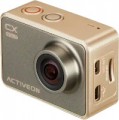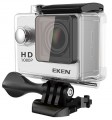Thread 1/4" (for tripod)
The presence of a
1/4" threaded socket on the camera body. It is this size that is standard for modern
tripods and is used in most of these devices. So this feature allows you to mount the camera on a tripod without using adapters and other additional equipment.
HD (720p)
The ability of the camera to record HD video (720p).
The official HD specification provides a resolution of 1280x720. However, in action cameras, there may be resolutions slightly different from this parameter, for example, 1080x720 or 1440x960. Anyway, HD is the most modest of today's high-definition standards, which, nevertheless, provides a fairly clear and detailed image.
Another important parameter given in this paragraph is the frame rate. The higher it is, the smoother the movement in the frame will be, and the details in dynamic scenes will be visible clearly. Technically,
30 fps or even less is enough for video, but
60 fps is considered the perfect value — at this frame rate, motion blur becomes almost imperceptible and at the same time the size of the captured files remains within reasonable limits. However, there are cameras on the market with higher frame rates at HD resolutions —
100 fps,
120 fps,
200 fps and even
240 fps. This speed is usually used for recording slow-motion video, but such a possibility needs to be specified separately.
Full HD (1080p)
The ability of the camera to shoot Full HD (1080p) video.
The standard image size in this standard is 1920x1080. However, in the case of action cameras, this category also includes some other resolutions that are similar in quality, for example, 1440x1080. In general, Full HD provides a very good balance between image quality, the volume of captured files and the processing power requirements for processing them, which makes this standard very popular in modern video equipment — both in cameras and in TV monitors.
Another important parameter given in this paragraph is the frame rate. The higher it is, the smoother the movement in the frame will be, and the details in dynamic scenes will be visible clearly. Technically,
30 fps or even
less is enough, but
60 fps is considered the perfect value — at this frame rate, motion blur becomes almost imperceptible and at the same time the size of the captured files remains within reasonable limits. However, there are cameras on the market with a higher frame rate at FullHD resolutions —
90 fps,
100 fps,
120 fps and even
240 fps. This speed is usually used for shooting slow-motion video, but the possibility of such shooting needs to be specified separately.
Ultra HD (4K)
The ability of the camera to shoot Ultra HD 4K video.
This format covers several resolutions in which the horizontal frame size is approximately 4K pixels. The most popular in action cameras is 3840x2160 (twice the FullHD frame on each side), but there are other options — for example, 3840x1920, corresponding to an aspect ratio of 2:1. In general, 4K is a kind of successor to Full HD: among HD standards that surpass Full HD, UltraHD is the most popular, in particular, many advanced TVs are produced with 3840x2160 screens. On the other hand, this format is quite demanding in terms of processing power and memory, so it is relatively rare in action cameras, mainly among premium models.
Another important parameter given in this paragraph is the frame rate. The higher it is, the smoother the movement in the frame will be, and the details in dynamic scenes will be visible clearly. However, in UltraHD mode, most modern action cameras produce a very low frame rate — most often
30 fps, and in some models
24 fps or even
15 fps. This video is quite viewable, but fast movement in the frame may look blurry. There are cameras capable of shooting UltraHD at a solid speed of
60 fps — the blurring effect during such shooting is almost imperceptible. However, such a model cost is high.
Field of view
For models with several lenses, as a rule, this parameter is indicated for each lens.
Most often (unless otherwise indicated), the specifications indicate the field of view by the diagonal of the frame; in some
ultra-wide-angle lenses it can exceed 180°. A special case is made up of lenses for which a 360° view is declared: this means that the optics cover the entire hemisphere in front of it. Such lenses are found in panoramic and 360-degree cameras (see “Product type”).
In general, the field of view primarily determines what area of the scene is being captured into the frame. Accordingly, the wider it is, the more space the camera captures, and the lower the likelihood that something that is happening will be off-screen. On the other hand, it is worth considering that a strong increase in the field of view leads to distortions of the “picture”, especially at the edges, as well as, to a decrease in the size of visible objects and a decrease in detail. Detailed recommendations regarding choosing a camera based on this parameter can be found in special sources.
Digital stabilization
The presence of a digital (electronic) stabilization system in the camera design.
Any stabilization is intended to compensate for small juddering of the image that occurs due to the instability of the hold in the hands, vibrations from the motor or road roughness (when used in transport), etc.
Digital stabilization is carried out as follows: a reserve area is allocated along the edges of the sensor, which under normal conditions does not participate in the formation of the final image. If the device is being shaken, the camera electronics select certain parts of the image from the reserve and build the image in such a way that in the end, it remains stable.
Compared to other methods of stabilization, digital systems are extremely simple and reliable. Moreover, they are inexpensive and have almost no effect on the weight, dimensions, and price of the camera. At the same time, with this method of stabilization, the effective area of the image sensor is reduced, which can adversely affect the image quality and the amount of noise on it.
Noise cancelation
The presence
of a active noise reduction system in the design of the action camera.
This function is relevant only for models with the ability to record sound (see above). The noise reduction system, by the name, monitors extraneous noise in the recorded sound (for example, the rumble of the wind in the microphone array) and eliminates them — thus, the camera captures only “useful” sound with a minimum of ambient noise. Of course, even the most advanced of these systems are not perfect, and errors in operation are inevitable — the camera may miss some noise or reduce the volume of a “useful” sound. However, in most cases, noise reduction somehow positively affects the quality of the recorded audio.
Microphones
The number of built-in microphones provided in the camera.
This parameter is indicated only for models that have
more than one microphone. This design provides additional capabilities, but the range of these capabilities depends on the number of microphones and the features of a particular model. So, most often such devices have two microphones; this can be a pair for recording stereo sound, or one microphone can work to record sound, and the second one can act as a sensor for the noise reduction system (see above). A larger number - 3 or 4 microphones - is found mainly in 360-degree cameras (see “Product type”), where such equipment is used to record “surround” multi-channel sound.
Megapixels
The number of megapixels in the action camera sensor, in other words, the resolution of this sensor(1 megapixel is 1 million photosensitive points).
There is an opinion that the higher the resolution, the better the image quality. It is true from the point of view that manufacturers are trying to install high-resolution sensors in advanced cameras. At the same time, there are no strict dependencies here, and from the technical point of view, the number of megapixels determines only the maximum image resolution that can be captured using this sensor. The quality of this picture will depend both on several features of the sensor itself (size, type, special design solutions), and the specs of the camera. So when choosing, you should focus not so much on the resolution of the image sensor, but on the general class of the camera and reviews with examples of footage.

